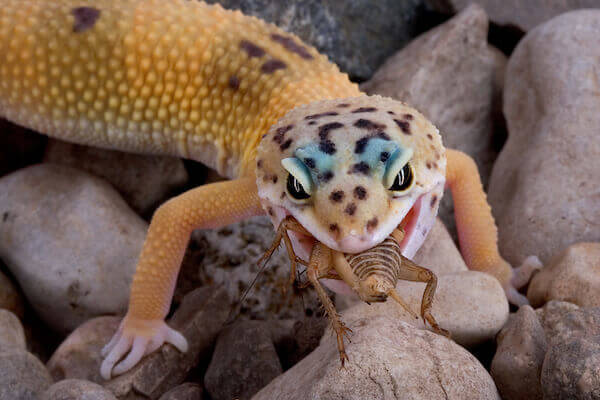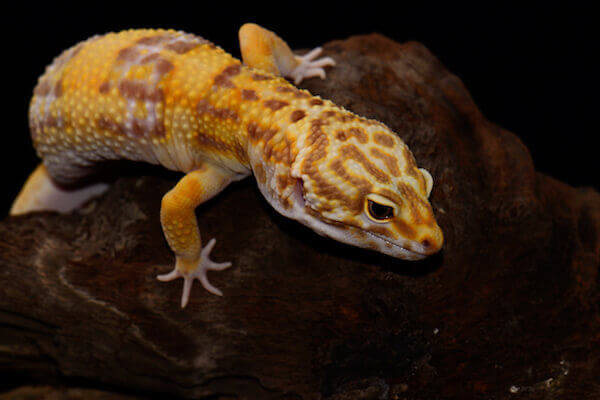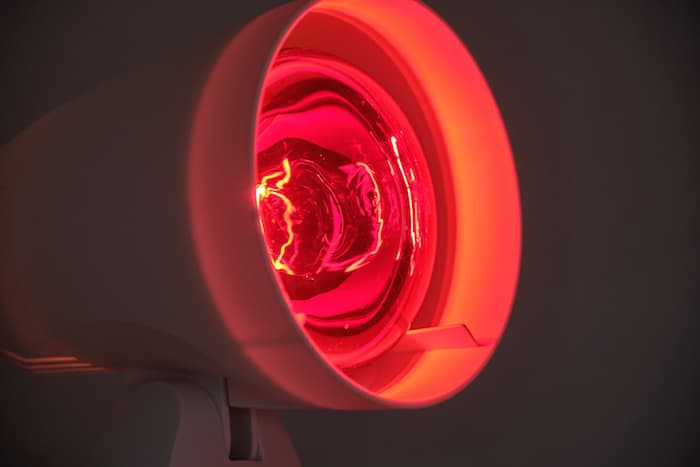Leopard geckos aren’t recognized for changing colors, so keep an eye on your gecko if you see any discoloration, such as yellowness. Check to see if the discoloration is a darker yellow or a brighter yellow; a darker yellow could indicate stress.
According to GeckoAdvice.com – “You may see the yellow tint when the leopard gecko is anxious or about to shed. It could indicate stress if you notice the yellow is a little darker than usual.”
Check to see if something in the tank is inflicting stress or whether the lighting setup is causing the discoloration. The temperature in the tank could be causing some of your gecko’s stress; try altering it to see if it helps.
It could also indicate that your leopard gecko is going to shed; therefore, if you know your gecko is due to shed, don’t be concerned. Keep an eye on their eating patterns. If they show any signs of stress, try to lessen it.
Why is my leopard gecko turning darker?
There are a variety of reasons why your leopard gecko is darkening or has a darker yellow tint than typical. One of the earliest indicators is a drop in ambient temperature; leopard geckos, like other reptiles, must maintain their body temperature.
That’s why they need a thermal gradient inside their tank so that the gecko can adjust their body temperature in both a chilly and warm zone.
Another reason could be that your leopard gecko is maturing, and as they mature, some colors become brighter than they were previously. Since they are growing, I would focus on their eating patterns more than discoloration if you have a younger leopard gecko. As they mature, their bodies are more prone to change.
Your leopard gecko is stressed
If your little buddy is stressed, it may begin to develop yellowness as a symptom of their distress. Many factors might cause stress in your leopard gecko, like the ambient temperature of their aquarium being too high or low, a change in their diet, or the leopard gecko being handled too much for its liking.
If the temperature in your leopard gecko’s tank is too hot or cold, it will be difficult for them to regulate their body temperature. If they have had a change in their diet, it may take some time for them to adjust. I would gradually introduce a new diet to your leopard gecko rather than making a drastic change on a set schedule. I’d also test whether the color fades if you hold or handle your leopard gecko less.
Nutritional deficiencies
We discussed the need to change your leopard gecko’s food, but it’s also critical to ensure that your leopard gecko is adequately nourished to avoid any discoloration. Leopard geckos, like humans, require calcium, vitamin D3, and other vitamins. Calcium deficiency can occur if they don’t get enough calcium, resulting in a deeper yellow coloration on your gecko. Put calcium powder around their tank for the leopard gecko to lick to avoid calcium deficiency.
The leopard geckos’ vitamin D3 solution is the UV light utilized in their tank; they rely on their nutrition more than illumination, but leopard geckos still use both. A heating rug should be placed beneath their tank for warmth. You may put a heating lamp on top of their tanks instead of the heated rug underneath if you have one. However, don’t use both simultaneously since this may cause your gecko’s ambient temperature to rise too high.
Overexposure to UV
UV lamps are commonly used as the primary heat source for leopard geckos, but they do not bask in the light. If feasible, place a heating rug under their tank; this is usually a better option. If your leopard gecko doesn’t have as much melanin in its body, the heating rug can help reduce UV exposure. UV exposure is more frequent in albino leopard geckos due to the lower melanin the albino geckos have. If you must use the UV light, reduce the time it is on or provide other hiding spots for your leopard gecko. Check to see if the reduced UV exposure aids in the treatment of their discoloration.
When you observe yellowing in your leopard gecko, check to see if it is being stressed by anything in their tank.
Keep an eye on their nutrition to make sure they’re getting enough vitamins and calcium. If your leopard gecko is still young, don’t worry about the dark yellow discoloration; instead, focus on their diet. The color of leopard geckos may just be forming or getting more brilliant as they grow.
If you know your leopard gecko is going to shed, darkening on the skin they are about to shed could be the cause. If you have an albino leopard gecko, try using a heating pad instead of UV to limit UV exposure.
Multiple reasons can cause discoloration in your leopard gecko, as previously stated. To ensure that none of these elements are stressing your leopard gecko, keep an eye on its food habits, tank surroundings, and UV exposure.
Related Reading



